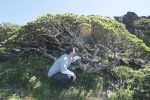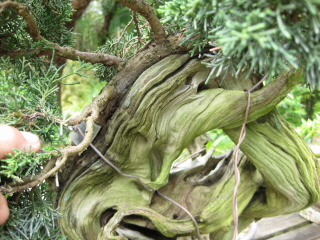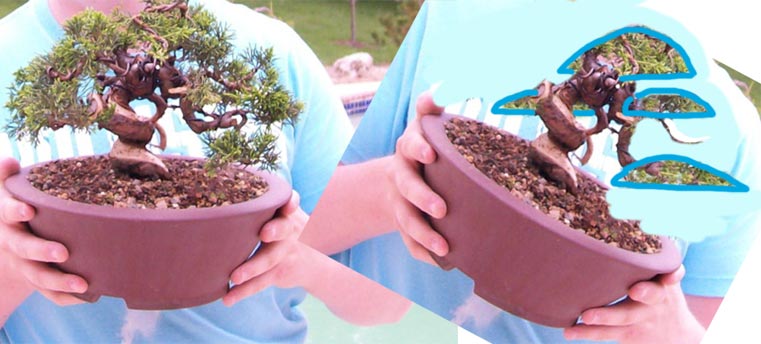My itoigawa shimpaku
+6
Rob Kempinski
DaveP
Kev Bailey
bonsai monkey
fiona
Garykk
10 posters
Page 1 of 2
Page 1 of 2 • 1, 2 
 My itoigawa shimpaku
My itoigawa shimpaku
This is an itoigawa shimpaku I styled in a workshop a couple of months ago.






Guest- Guest
 Re: My itoigawa shimpaku
Re: My itoigawa shimpaku
Very good but.....these twisted 'corkscreew' trained juniper are getting a bit predictable to me, almost repetitious. It requires allot of work and they finish out nice but I just don't know dawg if I am as enthused as I used to be...I dont know. Thanks for showing.
__gary
__gary
Garykk- Member
 Re: My itoigawa shimpaku
Re: My itoigawa shimpaku
First, so we're not entirely hijacking the poster's thread, it has to be said as a priority that Shimsuki has made a great job at the workshop of this particular tree. Well done. I'd be interested to see further development of this tree if you can post some pics over time. Could you also give some idea of the size of the tree as I'm only getting a rough idea from the pic with the hand in it. I'm seeing it as a Shohin size.Garykk wrote:these twisted 'corkscreew' trained juniper are getting a bit predictable to me, almost repetitious.
Re "predictability": there was a thread on the forum a coouple of months back in which the expression "cookie cutter bonsai" was used and it generated a lot of agreement. It seems to me that there are fashion trends in bonsai design just as there is in clothing. My own bonsai "guru" who was with me this week was bemoaning (possibly quite rightly) the fact that everything is being styled like a pine just now instead of going with the flow of the species and, more importantly, the individual tree. But is it not the case that the "juniper fashion" just now is being dictated to by the material coming in? At several bonsai nurseries in the last year, I have seen dozens of corkscrew junipers on the sales benches - so similar it actually is difficult to choose between them. And yes, I have to admit to buying a couple to work on - one Shohin and one Chuhin - for my collection. It seems to me that just as the mallsai market is saturated with lovely s-bend blue-potted Chinese Elms, we being dictated to now re the shape of junipers. Or was it always thus? I'm more and more seeing the attraction of yamadori. You get a fairly unique tree made all the more special because you've tramped across hill and dale in search of it.

fiona- Member
 Re: My itoigawa shimpaku
Re: My itoigawa shimpaku
Thanx for sharing your wonderful project.
I've recently had a workshop on a Itoigawa Juniper and I hope that I get as good an overall image as you have achieved. I'm sure it will as I had an excellent teacher and I must remember to post some images at some point.
The corkscrew debate. I really like them, probably 'cos I fancy one! A fellow student at the workshop I was at had one to work on and I must admit that I did get a bit "green eyed" but it was probably to do with the fact that I like their overal image when they are done well. There are plenty of ropey one's out there. By the end of the day though, given the choice, I still think that I would have taken mine home as it was a wee bit different from the norm.
Fiona
I like yamadori as well, mainly 'cos it's free. The more money I can save on trees/raw material the more I can spend on workshops & vodka!!!
I've recently had a workshop on a Itoigawa Juniper and I hope that I get as good an overall image as you have achieved. I'm sure it will as I had an excellent teacher and I must remember to post some images at some point.
The corkscrew debate. I really like them, probably 'cos I fancy one! A fellow student at the workshop I was at had one to work on and I must admit that I did get a bit "green eyed" but it was probably to do with the fact that I like their overal image when they are done well. There are plenty of ropey one's out there. By the end of the day though, given the choice, I still think that I would have taken mine home as it was a wee bit different from the norm.
Fiona
I like yamadori as well, mainly 'cos it's free. The more money I can save on trees/raw material the more I can spend on workshops & vodka!!!

bonsai monkey- Member
 Re: My itoigawa shimpaku
Re: My itoigawa shimpaku
bonsai monkey wrote:I like yamadori as well, mainly 'cos it's free.
Hi Simon, Gold and Diamonds are also free you simply have to did them out of the ground... why are we all not millionaires?
Guest- Guest
 Re: My itoigawa shimpaku
Re: My itoigawa shimpaku
I like the work. Any style can be overdone, but that doesn't diminish the skill that is required to take a piece of raw material and make a good tree out of it.
Tony is alluding to the skill that is required to spot the best yamadori among all the other opportunities out there. I know because I've collected with him a few times and he really has the knack.Gold and Diamonds are also free you simply have to did them out of the ground... why are we all not millionaires?

Kev Bailey- Admin
 Re: My itoigawa shimpaku
Re: My itoigawa shimpaku
Tony wrote:Hi Simon, Gold and Diamonds are also free you simply have to did them out of the ground... why are we all not millionaires?
Point taken Tony & thanks for the explaination Kev!
Your humble Padawan,
Simon

bonsai monkey- Member
 Re: My itoigawa shimpaku
Re: My itoigawa shimpaku
[quote="fionnghal"]

It is 7 inches.Garykk wrote:Could you also give some idea of the size of the tree as I'm only getting a rough idea from the pic with the hand in it. I'm seeing it as a Shohin size.

Guest- Guest
 Re: My itoigawa shimpaku
Re: My itoigawa shimpaku
[quote="bonsai monkey"]
Hi Simon, no need to be humble matey you are spot on with the fact that Yamadori is free, the problem is 'finding' them and all the effort involved... and if you talk to Lee... the injuries sustained and ensuing scars.
On this I love your idea of the discussion on "the ethics of collecting" at the ABBA event...count me in
Tony wrote:
Point taken Tony & thanks for the explaination Kev!
Your humble Padawan,
Simon
Hi Simon, no need to be humble matey you are spot on with the fact that Yamadori is free, the problem is 'finding' them and all the effort involved... and if you talk to Lee... the injuries sustained and ensuing scars.
On this I love your idea of the discussion on "the ethics of collecting" at the ABBA event...count me in
Guest- Guest
 Re: My itoigawa shimpaku
Re: My itoigawa shimpaku
That's gunna make a cracking little Shohin shimsuki 
Now I really have got a case of the Green Eyed Monster
Great work sir
Now I really have got a case of the Green Eyed Monster

Great work sir

bonsai monkey- Member
 Re: My itoigawa shimpaku
Re: My itoigawa shimpaku
Speaking to Kev's comment about Tony's eye... if you've ever perused Tony's site, this is fairly self-evident. Tony definitely has a knack for finding the gold among the pyrite! :-)
As to the "corkscrew" shimpku out there. The upside is the market is pretty well flooded with them in the US as well. The foliage is very nice and the trees are healthy, but the trunks lack character and a natural appearance. One of the better places I've seen this explained is on pg.37 of Cheng Cheng-Kung's Bonsai Shari Si-Diao (Vol 1: Manual Si-Diao) book.

(aside: this is an *excellent* book set, and while it's written in simplified Chinese, after purchase and upon request, Cheng can email you an English-translated PDF set - one for each book. ref: http://www.sidiao.com)
*But*, with some serious intestinal and/or testicular fortitude, the right tools, and a fair bit of practice on lesser material first, you can overcome the corkscrew. This requires the creation of some serious shari to reduce the wood mass and then compressing or expanding various curves in the trunk while changing some angles at the same time. The end result gets away from the "corkscrew". If you've parted with some healthy $$$ to obtain the tree in the first place, it takes some serious guts to rip into the tree. The tree *will* be nicer for it in the end.
One observation I've made is that the vast majority of trees with significant amounts of shari have the lifeline on the *inside* of the curves. This includes trees in nature (imho, trees in nature are the best model for creating shari and other deadwood). The working hypothesis I have is that this is due to two factors: a) the elements (wind, rain, sand, etc) contact the outside of the curves first, sparing the inside of the curves from nature's wrath. and b) the inside of the curves is the shortest path between the foliage and the roots, making it the most efficient path for the tree.
While I'm not a fan of the "cookie cutter" or "corkscrew" styles, they're a perfectly viable starting point if all else is good with the tree.
Kindest~
-d
As to the "corkscrew" shimpku out there. The upside is the market is pretty well flooded with them in the US as well. The foliage is very nice and the trees are healthy, but the trunks lack character and a natural appearance. One of the better places I've seen this explained is on pg.37 of Cheng Cheng-Kung's Bonsai Shari Si-Diao (Vol 1: Manual Si-Diao) book.

(aside: this is an *excellent* book set, and while it's written in simplified Chinese, after purchase and upon request, Cheng can email you an English-translated PDF set - one for each book. ref: http://www.sidiao.com)
*But*, with some serious intestinal and/or testicular fortitude, the right tools, and a fair bit of practice on lesser material first, you can overcome the corkscrew. This requires the creation of some serious shari to reduce the wood mass and then compressing or expanding various curves in the trunk while changing some angles at the same time. The end result gets away from the "corkscrew". If you've parted with some healthy $$$ to obtain the tree in the first place, it takes some serious guts to rip into the tree. The tree *will* be nicer for it in the end.
One observation I've made is that the vast majority of trees with significant amounts of shari have the lifeline on the *inside* of the curves. This includes trees in nature (imho, trees in nature are the best model for creating shari and other deadwood). The working hypothesis I have is that this is due to two factors: a) the elements (wind, rain, sand, etc) contact the outside of the curves first, sparing the inside of the curves from nature's wrath. and b) the inside of the curves is the shortest path between the foliage and the roots, making it the most efficient path for the tree.
While I'm not a fan of the "cookie cutter" or "corkscrew" styles, they're a perfectly viable starting point if all else is good with the tree.
Kindest~
-d
DaveP- Member
 Re: My itoigawa shimpaku
Re: My itoigawa shimpaku
[quote="Tony"]
The real point to be made is the lack of ethics in collecting.
The juniper looks good. The corkscrew shari is all the rage now. Commonality will diminish the tree a bit, but skill is still required to put the branches in a good position around the shari. Real innovation is to further bend the trunk, like Mario Komasta has shown in a recent posting of his work from Spain.
bonsai monkey wrote:Tony wrote:
Point taken Tony & thanks for the explaination Kev!
Your humble Padawan,
Simon
Hi Simon, no need to be humble matey you are spot on with the fact that Yamadori is free, the problem is 'finding' them and all the effort involved... and if you talk to Lee... the injuries sustained and ensuing scars.
On this I love your idea of the discussion on "the ethics of collecting" at the ABBA event...count me in
The real point to be made is the lack of ethics in collecting.

The juniper looks good. The corkscrew shari is all the rage now. Commonality will diminish the tree a bit, but skill is still required to put the branches in a good position around the shari. Real innovation is to further bend the trunk, like Mario Komasta has shown in a recent posting of his work from Spain.

Rob Kempinski- Member
 Re: My itoigawa shimpaku
Re: My itoigawa shimpaku
DaveP wrote:Speaking to Kev's comment about Tony's eye... if you've ever perused Tony's site, this is fairly self-evident. Tony definitely has a knack for finding the gold among the pyrite! :-)
One observation I've made is that the vast majority of trees with significant amounts of shari have the lifeline on the *inside* of the curves. This includes trees in nature (imho, trees in nature are the best model for creating shari and other deadwood). The working hypothesis I have is that this is due to two factors: a) the elements (wind, rain, sand, etc) contact the outside of the curves first, sparing the inside of the curves from nature's wrath. and b) the inside of the curves is the shortest path between the foliage and the roots, making it the most efficient path for the tree.
-d
Another reason might be that wet wood (the cambium in particular) is stronger in compression than in tension so when a branch bends the cambium on the outside of the branch will break and die while the cambium inside the curve will compress and survive. This is covered in my book BTW available at Haskilll Creek Press.

Rob Kempinski- Member
 Re: My itoigawa shimpaku
Re: My itoigawa shimpaku
Rob Kempinski wrote:
Another reason might be that wet wood (the cambium in particular) is stronger in compression than in tension so when a branch bends the cambium on the outside of the branch will break and die while the cambium inside the curve will compress and survive. This is covered in my book BTW available at Haskilll Creek Press.
Huh... quite logical! That's a great observation, Rob
Kindest~
-d
DaveP- Member
 Re: My itoigawa shimpaku
Re: My itoigawa shimpaku
This material is only a 'better than' blank canvas. In the hand of an 'imaginative' artist many different solutions could be arrived at. My take on this juniper is (and I have a one) is NOT to style it but grow it on, adding individual character to the raw material, then styling a few years later.
I had a workshop in Lisbon a couple of years ago and one of these junipers was brought along. The material was and is very good, the end result was a semi-cascade, the owner 'imagined' the finished tree in the same planting position as when purchased... shifting the angle changed his mind... Note: its what you do that transforms the material.
Marco Inver... told me that when these are grown in the field some growers randomly stamp on, snap and strip branches to add 'individuality' to the material, OK so the 'corkscrew' will always be there... its what you do with it that makes the difference... then again a good Rioja always works well for me.
Rob K...."The real point to be made is the lack of ethics in collecting." huuum... that is the reason for the debate... lets NOT hijack this post.
I had a workshop in Lisbon a couple of years ago and one of these junipers was brought along. The material was and is very good, the end result was a semi-cascade, the owner 'imagined' the finished tree in the same planting position as when purchased... shifting the angle changed his mind... Note: its what you do that transforms the material.
Marco Inver... told me that when these are grown in the field some growers randomly stamp on, snap and strip branches to add 'individuality' to the material, OK so the 'corkscrew' will always be there... its what you do with it that makes the difference... then again a good Rioja always works well for me.

Rob K...."The real point to be made is the lack of ethics in collecting." huuum... that is the reason for the debate... lets NOT hijack this post.
Guest- Guest
 Re: My itoigawa shimpaku
Re: My itoigawa shimpaku
Dave,
The page you are reffering to in Lao Tze Cheng Cheng Kung's book addresses the issue of three dimensional art on both the trunks and branches of trees. By studying the ecological effects of each particular plant, one will conclude that regular curving will NEVER occur in a natural state.
The illustrations you posted apply only to trees that grow in conditions where the wind, snow and other natural elements exercise an adverse effect on plant growth. For instance, conocarpus, premna and pemphis acidula endure conditions that will promote irregular and unpredictable 3D growth. Both Bonsai Shari Sidiao volumes give analysis to the proper creation of three dimensional effects on bonsai. This aspect is not limited to the branches and the trunks of trees. The 3D aspect applies to the canopy and the root structure as well. Evenly distributed roots as well as a perfectly rounded crown gives the same impression of what Gary reffers to as a 'cork screw' trunk.
Volume two of Shari Sidiao has a whole section dedicated to trees that grow in other climatological conditions like ficus, celtis and other broad leaf trees. The branch arrangement of these is quite disimilar to that of pines and conocarpus, but also is well influenced by the aspect of three dimensionality.
Kind regards,
Jose Luis
The page you are reffering to in Lao Tze Cheng Cheng Kung's book addresses the issue of three dimensional art on both the trunks and branches of trees. By studying the ecological effects of each particular plant, one will conclude that regular curving will NEVER occur in a natural state.
The illustrations you posted apply only to trees that grow in conditions where the wind, snow and other natural elements exercise an adverse effect on plant growth. For instance, conocarpus, premna and pemphis acidula endure conditions that will promote irregular and unpredictable 3D growth. Both Bonsai Shari Sidiao volumes give analysis to the proper creation of three dimensional effects on bonsai. This aspect is not limited to the branches and the trunks of trees. The 3D aspect applies to the canopy and the root structure as well. Evenly distributed roots as well as a perfectly rounded crown gives the same impression of what Gary reffers to as a 'cork screw' trunk.
Volume two of Shari Sidiao has a whole section dedicated to trees that grow in other climatological conditions like ficus, celtis and other broad leaf trees. The branch arrangement of these is quite disimilar to that of pines and conocarpus, but also is well influenced by the aspect of three dimensionality.
Kind regards,
Jose Luis

jrodriguez- Member
 Re: My itoigawa shimpaku
Re: My itoigawa shimpaku
Jose Luis,
I would completely agree with your comments! I absolutely love both volumes of this book and when combined with the excellent English translated version, think they should be core to the library of anyone interesting in seriously attempting to create the image of an ancient, nature-beaten tree!
Kindest Regards,
-d
I would completely agree with your comments! I absolutely love both volumes of this book and when combined with the excellent English translated version, think they should be core to the library of anyone interesting in seriously attempting to create the image of an ancient, nature-beaten tree!
Kindest Regards,
-d
DaveP- Member
 Re: My itoigawa shimpaku
Re: My itoigawa shimpaku
Dave,
Pu Quo Xie!!! No need to say those kind words. I had the opportunity to work on the english version alongside very talented young people. Lao Tze Cheng Cheng Kung's mission in bonsai creation is to disclose all techniques of bonsai in order to better the quality of WORLD BONSAI.
Xie Xie,
Jose Luis
Pu Quo Xie!!! No need to say those kind words. I had the opportunity to work on the english version alongside very talented young people. Lao Tze Cheng Cheng Kung's mission in bonsai creation is to disclose all techniques of bonsai in order to better the quality of WORLD BONSAI.
Xie Xie,
Jose Luis

jrodriguez- Member
 Re: My itoigawa shimpaku
Re: My itoigawa shimpaku
Erik Križovenský wrote:...one of several options...
Excellent idea.
I would suppress the lower branch on the right and bring down the one above instead.
A. Krzyzyk

AlainK- Member
 Re: My itoigawa shimpaku
Re: My itoigawa shimpaku
Erik Križovenský wrote:...one of several options...
No thanks, I like this tree how it is.
Guest- Guest
 Re: My itoigawa shimpaku
Re: My itoigawa shimpaku
I also don't like that lower right branch, it's *very* heavy. Perhaps if the foliage is grown-on to create a much larger pad, or a series of pads off that branch I might like it a bit more.
Kindest~
-d
Kindest~
-d
DaveP- Member
 Re: My itoigawa shimpaku
Re: My itoigawa shimpaku
Dave,
I believe the idea proposed by Erick is quite good and will give this tree the wild dynamism that's so typical of high mountain junipers. In my opinion, the right branch (in Erick's design proposal) is the soul of the tree; the trait that makes this tree a unique piece.
In He Huashan mountain and the Taroko National Park in Puli (Central Taiwan) it is possible to see very old and rugged junipers. My first visit to that place opened a new door for bonsai creation. By observing the trees in their natural habitat, it is possible to identify the natural purpose of jin and shari. Jin and shari elements are the rewards given by nature to trees that withstand harsh elements and yet survive the struggle to go on. By closely observing high mountain juniper, one can conclude that the dead elements of the tree serve a sole purpose: They protect the live part from wind and and blowing snow. Shari elements on trees are created in nature by strong winds that carry sand snow and other abrasive elements. These abrasive elements chew away the weak portions of the tree, leaving only the endurable hard wood. With the passing of time, weathering occurs in the form of polished shari. For that reason, it is quite unnatural to see green growth placed in front of or at the sides of dead portions of the tree. In nature and from all the trees i've had the opportunity to study, it does not happen that way.
Remember, my Pentsai or bonsai school of thought comes from Lao Tze Cheng Cheng Kung. We strongly belive that by studying the ecological conditions of trees, it is possible to identify those traits that are natural to a particular species, thus transporting them to our bonsai creations. As an art, bonsai can find many forms of expression. One is not better than the other, but only the standart is higher or more advanced. For example, Indonesian Casuarina and Zhou Niang Tze (Premna) is among the best in the world, so is Malaysian Wrigthia. Kinmen Longsu (Ficus), Mao Pu (Celtis) and Taiwan juniper are probably of the highest quality. Japanese white pine is incredible. Korean Taxus and Black Pine are very stunning. Phillippine Pemphis is spectacular. By combining and learning the particular traits and idiosyncracies of each particular species and by combining them with our own vision, a new world of bonsai creation will emerge.
Kind regards,
Jose Luis
I believe the idea proposed by Erick is quite good and will give this tree the wild dynamism that's so typical of high mountain junipers. In my opinion, the right branch (in Erick's design proposal) is the soul of the tree; the trait that makes this tree a unique piece.
In He Huashan mountain and the Taroko National Park in Puli (Central Taiwan) it is possible to see very old and rugged junipers. My first visit to that place opened a new door for bonsai creation. By observing the trees in their natural habitat, it is possible to identify the natural purpose of jin and shari. Jin and shari elements are the rewards given by nature to trees that withstand harsh elements and yet survive the struggle to go on. By closely observing high mountain juniper, one can conclude that the dead elements of the tree serve a sole purpose: They protect the live part from wind and and blowing snow. Shari elements on trees are created in nature by strong winds that carry sand snow and other abrasive elements. These abrasive elements chew away the weak portions of the tree, leaving only the endurable hard wood. With the passing of time, weathering occurs in the form of polished shari. For that reason, it is quite unnatural to see green growth placed in front of or at the sides of dead portions of the tree. In nature and from all the trees i've had the opportunity to study, it does not happen that way.
Remember, my Pentsai or bonsai school of thought comes from Lao Tze Cheng Cheng Kung. We strongly belive that by studying the ecological conditions of trees, it is possible to identify those traits that are natural to a particular species, thus transporting them to our bonsai creations. As an art, bonsai can find many forms of expression. One is not better than the other, but only the standart is higher or more advanced. For example, Indonesian Casuarina and Zhou Niang Tze (Premna) is among the best in the world, so is Malaysian Wrigthia. Kinmen Longsu (Ficus), Mao Pu (Celtis) and Taiwan juniper are probably of the highest quality. Japanese white pine is incredible. Korean Taxus and Black Pine are very stunning. Phillippine Pemphis is spectacular. By combining and learning the particular traits and idiosyncracies of each particular species and by combining them with our own vision, a new world of bonsai creation will emerge.
Kind regards,
Jose Luis

jrodriguez- Member
 Re: My itoigawa shimpaku
Re: My itoigawa shimpaku
jrodriguez wrote:Dave,
I believe the idea proposed by Erick is quite good and will give this tree the wild dynamism that's so typical of high mountain junipers. In my opinion, the right branch (in Erick's design proposal) is the soul of the tree; the trait that makes this tree a unique piece.
I can see how that might work, given additional development ...and based on your next comments.
jrodriguez wrote:
In He Huashan mountain and the Taroko National Park in Puli (Central Taiwan) it is possible to see very old and rugged junipers. My first visit to that place opened a new door for bonsai creation. By observing the trees in their natural habitat, it is possible to identify the natural purpose of jin and shari. Jin and shari elements are the rewards given by nature to trees that withstand harsh elements and yet survive the struggle to go on. By closely observing high mountain juniper, one can conclude that the dead elements of the tree serve a sole purpose: They protect the live part from wind and and blowing snow.
I do have a book in my collection which is a photo tour of the Junipers from the Taroko National Park. It's truly an amazing sight and a great reference, particularly when applied to your first comment above.
jrodriguez wrote:Shari elements on trees are created in nature by strong winds that carry sand snow and other abrasive elements. These abrasive elements chew away the weak portions of the tree, leaving only the endurable hard wood. With the passing of time, weathering occurs in the form of polished shari. For that reason, it is quite unnatural to see green growth placed in front of or at the sides of dead portions of the tree. In nature and from all the trees i've had the opportunity to study, it does not happen that way.
I wholly agree! ..although this does not tend to be found in the more refined bonsai forms normally seen from Japan or the West.
jrodriguez wrote:Remember, my Pentsai or bonsai school of thought comes from Lao Tze Cheng Cheng Kung. We strongly belive that by studying the ecological conditions of trees, it is possible to identify those traits that are natural to a particular species, thus transporting them to our bonsai creations. As an art, bonsai can find many forms of expression. One is not better than the other, but only the standard is higher or more advanced. For example, Indonesian Casuarina and Zhou Niang Tze (Premna) is among the best in the world, so is Malaysian Wrigthia. Kinmen Longsu (Ficus), Mao Pu (Celtis) and Taiwan juniper are probably of the highest quality. Japanese white pine is incredible. Korean Taxus and Black Pine are very stunning. Phillippine Pemphis is spectacular. By combining and learning the particular traits and idiosyncracies of each particular species and by combining them with our own vision, a new world of bonsai creation will emerge.
I would agree here, but might rephrase "the standard is higher or more advanced" to be "the standard is different, it is art imitating life." To say that the standard is higher would imply that one is better than another, when they're simply different. I do wish I had the means to spend considerable time studying with Cheng Cheng Kung (among others!). It's clear from his works - both written and bonsai - that he has deeply contemplated how nature works and how that can be effectively expressed through the art of bonsai. Even when scaled down to shohin-sized bonsai, his philosophy translates well!
I don't have a particular "style" of bonsai that I prefer; Chinese, Japanese, Western, Natural - they all can produce different images and evoke different emotions. In my experience, people tend to prefer one over another. In my opinion, part of the limitation in providing comments to trees like Erik's is that the basis of the comments comes from one style or another. One style isn't better or worse than another, but what does work well is combining the owner's vision for the tree with a style that works with the tree. As you point out, if you change the thinking to a combination of Natural and Chinese, the lower right branch suddenly becomes a key part of the tree. In Japanese or Western, the thickness of the branch becomes problematic (but not insurmountable - it can be retained and worked into the design).
Just some thoughts...
Thank you for sharing!
Kindest,
-d
Kind regards,
Jose Luis[/quote]
DaveP- Member
Page 1 of 2 • 1, 2 
 Similar topics
Similar topics» Shimpaku "Itoigawa"
» second style itoigawa shimpaku
» before, during, after - first style itoigawa shimpaku
» Twisted Itoigawa Shimpaku Progression
» Itoigawa Shimpaku 6 years in training
» second style itoigawa shimpaku
» before, during, after - first style itoigawa shimpaku
» Twisted Itoigawa Shimpaku Progression
» Itoigawa Shimpaku 6 years in training
Page 1 of 2
Permissions in this forum:
You cannot reply to topics in this forum









